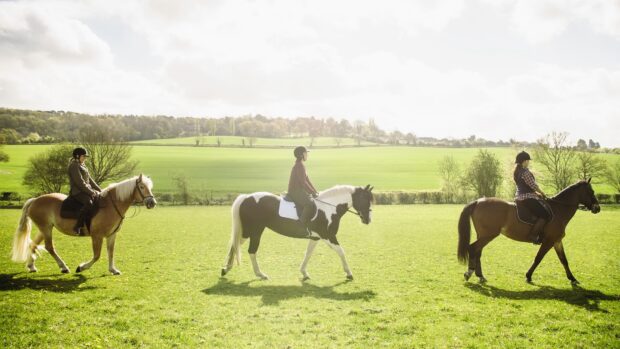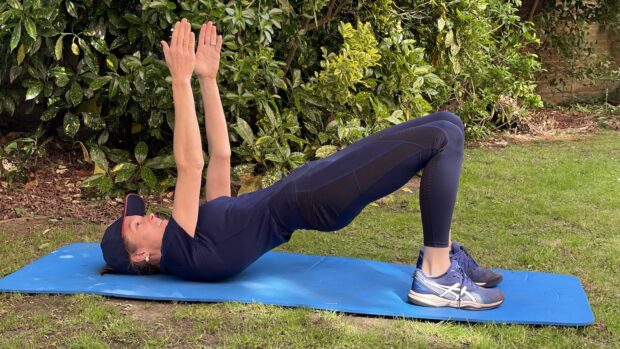It can be easy to forget about your own fitness when you are focused on keeping your horse in peak condition. Here, sports therapist Debbie Rolmanis explains the importance of a rider's core — and busts some misconceptions about it
Arenas around the globe are full of a familiar cry of “your core needs to be stronger”, and it is used for the rider who cannot sit to the trot all the way up to those unable to conquer a clean flying change.
It has become the go-to, get out of jail free card for every unbalanced piece of riding and whilst the message that a strong core will give you an independent seat is not inherently wrong, piggy backing off the fitness industry’s obsession with a six pack, is.
So, what really is the core?
To be biomechanically correct, the core should be thought of as every muscle that attaches to the pelvis (of which there are over 30 including attachments to the sacrum and the hips).
The pelvis really is the biomechanic super power of the human body, and for the rider it is especially critical as it becomes the base of support in the saddle. Every movement of the horse is received by the pelvis.
That means that all the muscles which connect to this titan of a structure; above, below, front, back, side to side, superficial and deep, will have an impact on the positioning of the body in the saddle.
Thinking of the core as this entire unit will give the rider a much more accurate and holistic approach to ‘core training’ and how it influences everything; from how the upper body is stacked above the pelvis, to how the legs hang beneath it.
Back to front
Mechanically, the strongest part of the body should be the posterior chain — ie the muscles at the back of the body; lower back, glutes and hamstrings.
In days of old we would’ve used our bodies in a way that complimented this design; every movement our ancestors made in the form of squatting, pulling, pushing etc would be strengthening the back and keeping the hips mobile. Modern day compressive living leaves us shortening the front of the body and leaving the posterior chain lengthened and weak.
Sitting for long periods of time presses against the hamstrings which restricts the bloodflow they receive, putting them into a habitually shortened and weak position.
At the same time it lengthens and weakens the glutes and tightens the hip flexors. The upper body begins to fold forward, shortening the front of the body. In clear terms, all we are succeeding at is bringing the nose and the knees closer together. And nobody wants that.
Unravelling this posture is not possible by just standing up (however this does help) as habitual shortening of the front of the body pulls the pelvis out of optimal alignment, even when standing.
Transferring this misalignment and weakness into the saddle creates an incredibly difficult challenge for the pelvis. Trying to maintain balance and stability when it has to constantly adjust to the horses’ movement with poor “complete” strength becomes a near impossibility.
Crunch time: how does the core work?
This network of muscles that attach to the pelvis are a complete unit. They are constantly communicating with each other and when the body is aligned and functioning correctly they are happily all speaking the same language.
The muscles of the lower back, who have been assigned the role of the strongest member of the team, dictate the conversation. When these muscles are switched on and strong, their communication (via spinal stabilisation) tells the abdominal muscles to switch on at the level of strength required. That is a key piece of information. If the body is working correctly, the lower back fires up and provides intelligence to the abdominal corset on how strong it needs to be. It is the conductor of the orchestra, the CEO, the captain of the ship. You get the idea. It’s the boss.
Unfortunately, when the lower back musculature is weak and abused from poor movement, it cannot stabilise the spine and therefore cannot direct the rest of the core muscles into their roles.
Targeting the front of the body (standard “core” training) without looking after the posterior muscles, is similar to communicating vital statistics on a phone with poor signal. Information is lost and the result is unsatisfactory.
Without the leadership of the lower back, targeting the front part of the core becomes purely an exercise in shortening the abdominals whilst closing the gap between the vertebrae of the lumbar spine, which ultimately means damage and pain.
The message here is that the lower back needs to be the first one on the list of priorities. When we are able to align and strengthen this area, the abdominals at the front and sides of the body are able to switch on and carry out their supportive roles with the appropriate level of tension.
The hips
The function of the hips forms a massive part of this story of looking at the “complete core”.
The muscles below the pelvis, particularly the glutes and hamstrings are key to the correct function of the pelvis and the hips, which is vital for the rider. In order to sit in the saddle with a long, elegant leg the rider needs to take the hip into some external rotation and extension (moving the leg towards the back of the horse), which requires the glutes and hamstrings to be firing.
The unavoidable truth is that most riders have at least one hip they wished could be traded in, and once again, we have to look at the effect of compressive living; that is a habitually seated posture that closes our hip joint and makes our butt muscles disappear.
The result is a hip that cannot move into extension (glutes weak, stretched and unable to contract) which impacts the positioning of the pelvis, the leg and the upper body in the saddle.
The hips should be the main fulcrum of the body, and treating every muscle that attaches to the pelvis as part of the core ensures that the hips start to regain some mobility.
Find out more at dbmuscletherapy.com
- To stay up to date with all the breaking news throughout all the major shows in 2025, subscribe to the Horse & Hound website
You may also be interested in:

Rider biomechanics: 13 things to bear in mind if you want to be a good rider

Subscribe to Horse & Hound magazine today – and enjoy unlimited website access all year round



